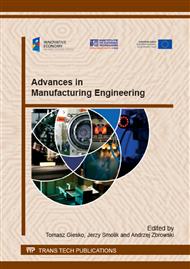p.3
p.11
p.19
p.27
p.35
p.46
p.54
p.62
Preliminary Assessment of the Influence of the Type of a Curing Agent upon Impact Loading of a Multi-Layered Composite
Abstract:
The properties of a multi-layered composite can be moulded through a selection of type, shape, and the number of layers of reinforcement material as well as powder fillers. Furthermore, the type and share of the matrix as well as the kind of hardeners also exert a significant influence on mechanical properties of composites. We attempted to experimentally establish the influence of the type of hardeners on mechanical properties. The test used Charpy’s hammer, and it was performed in the configuration of impact loading parallel to the edge. We prepared specimens of the materials. The specimens contained 12 layers of different fibre reinforcement: aramid (kevlar) fibre of 230 g/m2 basis weight, glass fibre of 150 g /m2, and carbon fibre of 160 g/m2 basis weight. The base was epoxy resin – Epidian 52, which was cured at room temperature by means of the following curing agents: PAC, TFF or Z-1, manufactured by Z. Ch. Organika-Sarzyna S.A. in Nowa Sarzyna. The experiments proved the tremendous influence of the type of the hardeners on toughness KC. It can be increased even by 25% for glass fibre reinforcement, about 20% for carbon fibre reinforcement and about 10% for aramid fibre reinforcement due to the use of an appropriate type of hardener.
Info:
Periodical:
Pages:
19-26
Citation:
Online since:
November 2014
Authors:
Keywords:
Price:
Сopyright:
© 2015 Trans Tech Publications Ltd. All Rights Reserved
Share:
Citation:


